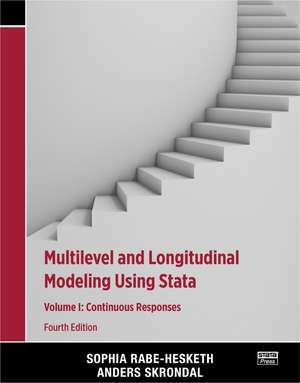Multilevel and Longitudinal Modeling Using Stata, Volume I: Continuous Responses
Autor Sophia Rabe-Hesketh, Anders Skrondalen Limba Engleză Paperback – 22 oct 2021
Preț: 501.86 lei
Preț vechi: 545.50 lei
-8% Nou
Puncte Express: 753
Preț estimativ în valută:
96.03€ • 100.80$ • 79.71£
96.03€ • 100.80$ • 79.71£
Carte disponibilă
Livrare economică 20 martie-03 aprilie
Livrare express 06-12 martie pentru 57.63 lei
Preluare comenzi: 021 569.72.76
Specificații
ISBN-13: 9781597181372
ISBN-10: 1597181374
Pagini: 544
Dimensiuni: 188 x 240 x 37 mm
Greutate: 1.21 kg
Ediția:4 ed
Editura: Stata Press
Colecția Stata Press
ISBN-10: 1597181374
Pagini: 544
Dimensiuni: 188 x 240 x 37 mm
Greutate: 1.21 kg
Ediția:4 ed
Editura: Stata Press
Colecția Stata Press
Public țintă
Academic, Postgraduate, and Professional Practice & DevelopmentCuprins
I. Preliminaries 1. Review of linear regression II. Two-level models 3. Random-intercept models with covariates 4. Random-coefficient models III. Models for longitudinal and panel data; Introduction to models for longitudinal and panel data (part III) 5. Subject-specific effects and dynamic models 6. Marginal models 7. Growth-curve models IV. Models with nested and crossed random effects 8. Higher-level models with nested random effects 9. Crossed random effects
Notă biografică
Sophia Rabe-Hesketh is a professor of educational statistics and biostatistics at the University of California, Berkeley.
Anders Skrondal is a senior biostatistician at the Centre for Fertility and Health, Norwegian Institute of Public Health and an adjunct professor at the University of Oslo and at the University of California, Berkeley.
Anders Skrondal is a senior biostatistician at the Centre for Fertility and Health, Norwegian Institute of Public Health and an adjunct professor at the University of Oslo and at the University of California, Berkeley.
Descriere
Multilevel and Longitudinal Modeling Using Stata, Fourth Edition, is a complete resource for learning to model data in which observations are grouped. Volume I focuses on linear models for continuous outcomes.
